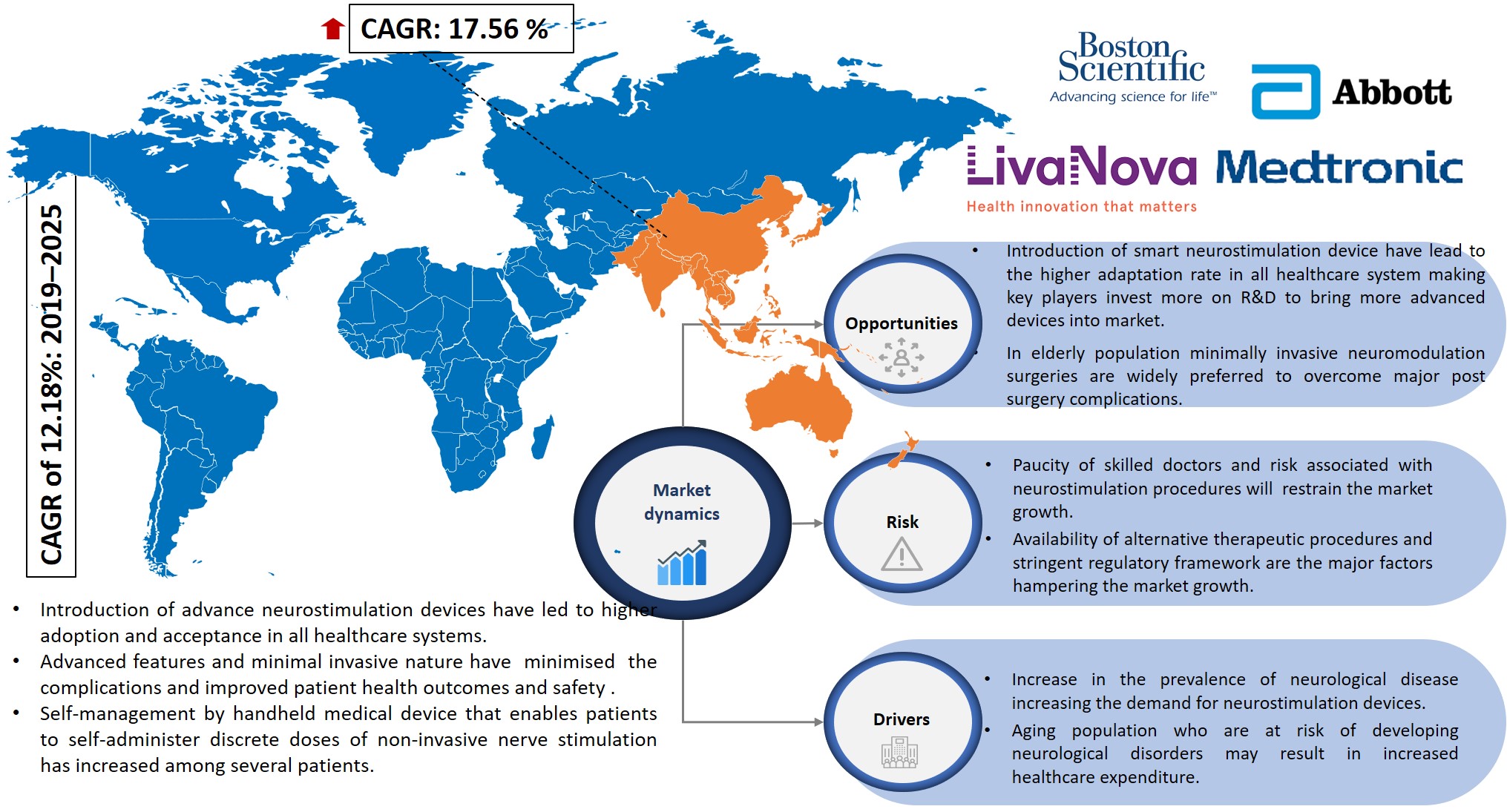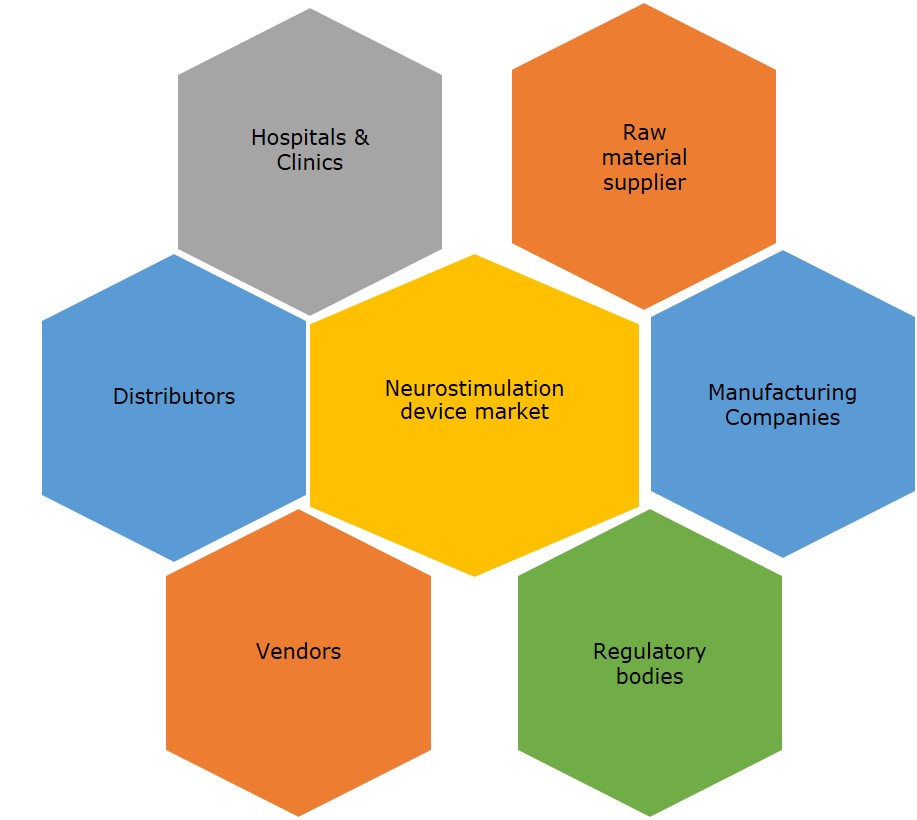
Global Neurostimulation Devices Market By Product Type (SCS, DBS, SNS, VNS, and GES), By Applications Type (Pain Management, Urinary & Fecal Incontinence, and Epilepsy), By End-users (Hospitals and Trauma Centers), and By Regions (North America, Europe, APAC, and RoW) – Forecast up to 2025
- April, 2020
- Domain: Healthcare - Medical Devices
- Get Free 10% Customization in this Report
This market research report includes a detailed segmentation of the global neurostimulation devices market by product type (SCS, DBS, SNS, VNS, and GES), by applications type (pain management, urinary & fecal incontinence, and epilepsy), by end-users (hospitals and trauma centers), and by regions (North America, Europe, APAC, and RoW).
Research Overview
Infoholic Research predicts that the global neurostimulation devices market will grow at a CAGR of 12.18% during the forecast period 2019–2025. Neurostimulation devices are designed specifically to treat various conditions effectively by delivering low voltage electricity to specific parts of the patient brain, spinal cord, or peripheral nervous system. Several kinds of research have revealed that neurostimulation therapy has improved the ability to function and participate in activities of daily living. Thus, neurostimulation devices are found to be effective among patients suffering from various neurological disorders, thereby influencing the growth of the global neurostimulation devices market. The drug-free advantages of neurostimulation devices in chronic pain management without opioids can be a lifesaver for many as it avoids the systemic impacts and possible addictive outcomes of drug therapy. Their promising results in improving the quality of life have enabled many healthcare providers and facilities to deliver rapid, safe, and effective treatment procedures.
Recent advancements in neurotechnology and neuroimaging, along with an increased understanding of neurocircuitry, are providing the necessary tools to treat patients with many debilitating neurologic and psychiatric disorders that are contributing to the rapid rise in the use of neurostimulation therapies. After remaining relatively stagnant for the past 30 years, electrical stimulation technologies are evolving toward potential closed-loop therapeutic control systems with the ability to deliver stimulation with a higher spatial resolution to provide continuously customized neuromodulation for optimal clinical outcomes. Also, advancements such as electrode design to enable long-term high-precision sensing and stimulating as well as computing approaches to acquire and assess meaningful feedback signals in real-time to adapt stimulation parameters accordingly are boosting the neurostimulation devices market. With the advent of new technologies-enabled devices, manufacturers have focused on developing tools and devices that transform disease treatment on a global scale to be less toxic, less invasive, and more effective, using precise ultra-low radiofrequency energy. Such promising results of neurostimulation devices are making manufacturers invest more in R&D for the development of advanced products. Hence there would be a growing demand for the development of effective neurovascular devices and commercialization during the forecast period.

North America is considered as the largest region in the global neurostimulation devices market due to extensive technological advancements, sophisticated healthcare infrastructures, and various government initiatives in the region. Europe was observed to be the second-largest region in the neurostimulation devices market owing to the presence of a large number of manufacturers in the region. The major factor driving the market in Asia Pacific includes the acceptance and demand for high-end medical infrastructure in the region. China, Japan, and India are expected to grow at a faster rate when compared to other countries in the Asia Pacific region.
Segmentation by Product Type:
- SCS system
- DBS system
- SNS system
- VNS system
- GES system
The spinal cord stimulator (SCS) system accounted for the largest revenue-generating segment due to the large population base suffering from chronic pain, following major surgeries and spinal cord injuries.
Segmentation by application:
- Pain Management
- Urinary and Fecal Incontinence
- Epilepsy
Pain management segment was leading with largest revenue owing to higher adaptation of these devices to manage chronic pain in all age groups.
Segmentation by End-users:
- Hospitals
- Trauma centers
In 2018, the hospital segment was leading with maximum revenue in the global neurostimulation device market with a large number of users and patients globally.
Segmentation by Region:
- North America
- Europe
- APAC
- RoW
The regions covered in the report include North America, Europe, Asia Pacific, and Rest of the World. North America is set to be the leading region in the global neurostimulation devices market, followed by Europe. Asia Pacific and RoW are set to be the emerging regions. The emerging markets have a high potential to grow owing to an increase in the patient population and focus on various chronic disorders. The global neurostimulation devices market is likely to seek a steady penetration rate in the emerging market, and most of the vendors are targeting to penetrate India, China, and Japan markets. Further, factors such as large patient population and government initiatives have become a new trend in the emerging markets.
Competitive Analysis – The vendors have a strong focus on introducing technologically advanced cost-effective devices with long battery, improved efficiency, safety, user-friendliness, and miniaturization to improve patients' experience and clinical outcomes, which are making global neurostimulation devices market a highly competitive market. Growing demand for the detection of illnesses, including gastroparesis, Parkinson's disease, dystonia, and depression, are providing tremendous opportunities for players to come up with product enhancements and leverage their product portfolio globally. This may further heat the competition among existing vendors leading to the development of products in less time and fasten the regulation process with effective means to commercialize the product early into the market to stay dominant. Favorable government policies are also making way for other small companies to enter the market, which is striving to develop simulators.
Key Vendors:
- Medtronic plc
- Abbott Laboratories 65
- Boston Scientific Corporation
- Cyberonics, Inc (LivaNova, PLC)
Key Competitive Facts:
- The market is highly competitive, with all the players competing to gain the market share. Intense competition, rapid advancements in technology, frequent changes in government policies, and price are key factors that confront the market.
- The requirement of high initial investment, implementation, and stringent regulatory framework in the market are also limiting the entry of new players.
- Responding to competitive pricing pressures specific to each of the geographic markets.
- Protection of proprietary technology for products and manufacturing processes.
Benefits –The report provides complete details about the importance and adoption rate of neurostimulation devices. Thus, the key stakeholders can know about the major trends, drivers, investments, vertical player’s initiatives, and government initiatives toward the medical devices segment in the upcoming years along with details of the pureplay companies entering the market. Moreover, the report provides details about the major challenges that are going to impact the market growth. Additionally, the report gives complete details about the key business opportunities to stakeholders in order to expand their business and capture the revenue in specific verticals and to analyze before investing or expanding the business in this market.
Key Takeaways:
- Understanding the potential market opportunity with precise market size and forecast data.
- Detailed market analysis focusing on the growth of the neurostimulation devices market globally.
- Factors influencing the growth of the neurostimulation devices market.
- In-depth competitive analysis of dominant and pureplay vendors.
- Prediction analysis of the neurostimulation products industry across the globe.
- Key insights related to major segments of the neurostimulation devices market globally.
- The latest market trend analysis impacting the buying behavior of the consumers.
Key Stakeholders:

- Industry Outlook
- Industry Overview
- Definition
- Why Neurostimulation Devices?
- Reimbursement Scenario
- Emerging Global Markets
- Industry Trends
- PEST Analysis
- Industry Overview
- Report Outline
- Report Scope
- Report Summary
- Research Methodology
- Report Assumptions
- Market Snapshot
- Total Addressable Market
- Segmented Addressable Market
- Related Markets
- Surgical Devices Market
- Neurology Endoscopy Devices Market
- Neurointerventional Devices Market
- Neurovascular Stent Retriever Market
- Intracranial Pressure Monitor Market
- Market Outlook
- Regulatory Bodies & Standards
- Government Spending and Initiatives
- Porter 5 (Five) Forces
- Market Characteristics
- Evolution
- Ecosystem
- Market Segmentation
- Market Dynamics
- Drivers
- Increase in the prevalence of neurological disorders
- Increasing demand for neurostimulation devices
- Growing aging population
- Rising healthcare expenditure
- Restraints
- Risks and complications associated with neurostimulation procedures
- Paucity of skilled doctors
- Alternative therapeutic procedures
- Stringent regulatory framework
- Opportunities
- Introduction of smart neurostimulation devices
- Rise in the adoption of minimally invasive neuromodulation surgeries
- Funding for R&D
- DRO – Impact Analysis
- Drivers
- Trends, Roadmap and Projects
- Market Trends & Impact
- Technology Roadmap
- Chapter 1
- Overview
- BEM Success Factors
- BEM Microsystem
- BEM Platform Functionality
- Instrumentation Capabilities
- Modeling and Simulation
- Neural Interfaces
- Biocompatible Packaging
- Chapter 7
- Chapter 8
- Chapter 1
- Product: Market Size and Analysis
- Overview
- SCS System
- Market Size and Forecast
- DBS System
- Market Size and Forecast
- SNS System
- Market Size and Forecast
- VNS System
- Market Size and Forecast
- GES System
- Market Size and Forecast
- Application: Market Size and Analysis
- Overview
- Pain Management
- Market Size and Forecast
- Urinary and Fecal Incontinence
- Market Size and Forecast
- Epilepsy
- Market Size and Forecast
- End-user: Market Size and Analysis
- Overview
- Hospitals
- Trauma Centers
- Regions: Market Size and Analysis
- Overview
- North America
- Overview
- Europe
- Overview
- Asia Pacific
- Overview
- Rest of the World
- Overview
- Competitive Landscape
- Overview
- Competitive Comparison Analysis
- Vendors Profiles
- Medtronic plc
- Abbott Laboratories
- Boston Scientific Corporation
- Cyberonics, Inc. (LivaNova, PLC)
- Companies to Watch For
- Nuvectra Corporation
- Nevro Corp.
- STYMCO Medical, LLC
- NeuroMetrix, Inc.
- NeuroPace, Inc.
- Synapse Biomedical
Annexure
Research Framework
Infoholic Research works on a holistic 360° approach in order to deliver high quality, validated and reliable information in our market reports. The Market estimation and forecasting involves following steps:
- Data Collation (Primary & Secondary)
- In-house Estimation (Based on proprietary data bases and Models)
- Market Triangulation
- Forecasting

Market related information is congregated from both primary and secondary sources.
Primary sources
Involved participants from all global stakeholders such as Solution providers, service providers, Industry associations, thought leaders etc. across levels such as CXOs, VPs and managers. Plus, our in-house industry experts having decades of industry experience contribute their consulting and advisory services.
Secondary sources
Include public sources such as regulatory frameworks, government IT spending, government demographic indicators, industry association statistics, and company publications along with paid sources such as Factiva, OneSource, Bloomberg among others.






